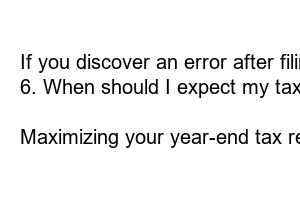연말정산 환급금 미리 보기
Title: Preview of Year-End Tax Refund: How to Maximize Your Returns
Introduction:
Are you eagerly awaiting your year-end tax refund? It’s that time of the year when many individuals start planning how to make the most of their tax returns. In this blog post, we will provide you with a comprehensive overview of the year-end tax refund, offering valuable insights on how you can optimize your returns. Let’s dive in!
1. Understanding the Year-End Tax Refund:
A year-end tax refund is the amount of money you receive from the government when you’ve paid more taxes throughout the year than what you owe. It’s a welcome financial boost that can be used in various ways to fulfill your financial goals and aspirations.
2. Efficiently Organize Your Tax Documentation:
To make the most of your year-end tax refund, it’s essential to organize all your tax-related documents, such as W-2s, 1099s, and receipts, before approaching a tax professional. This will ensure a swift and accurate processing of your tax return.
3. Deductions and Tax Credits:
Explore all possible deductions and tax credits available to you. By identifying eligible deductions such as mortgage interest, student loan interest, and charitable contributions, you can significantly reduce your taxable income and increase your potential refund.
4. Retirement Contributions:
Contributing to retirement funds, such as 401(k) or IRA, not only helps secure your future but can also bring immediate tax benefits. By allocating a portion of your income to retirement savings, you can lower your taxable income and potentially increase your refund.
5. Optimize Your Withholdings:
Review your W-4 form and ensure that your withholdings are accurately aligned with your financial situation. By avoiding unnecessary over-withholding or under-withholding, you can optimize your tax payments throughout the year and avoid unpleasant surprises during tax season.
6. Plan for the Future:
Consider using your tax refund strategically to enhance your financial well-being. Whether it’s paying down debt, investing in education or property, or building an emergency fund, thoughtful planning can help you leverage your refund to secure a better future.
FAQs (Frequently Asked Questions):
1. Can I get my tax refund faster?
Yes, electronic filing and choosing direct deposit can expedite the refund process, giving you faster access to your money.
2. What if I owe taxes instead of receiving a refund?
If you owe taxes, consult a tax professional as soon as possible to explore payment options and avoid potential penalties.
3. Are there any tax deductions for self-employed individuals?
Yes, self-employed individuals can claim deductions for business-related expenses, such as office supplies, travel, and health insurance.
4. Can I track the progress of my tax refund?
Yes, the IRS provides tools like “Where’s My Refund?” where you can track the status of your refund.
5. What if I have made an error on my tax return?
If you discover an error after filing your tax return, you can file an amended return using Form 1040X to correct the mistake.
6. When should I expect my tax refund?
Typically, electronic filers receive their tax refunds within three weeks, while paper filers may have to wait longer, around six to eight weeks.
Summary:
Maximizing your year-end tax refund involves efficient organization of tax documents, exploring deductions and tax credits, optimizing retirement contributions, and careful planning for the future. By taking these steps and avoiding unnecessary errors, you can make the most of your tax refund, ensuring a brighter financial outlook.

